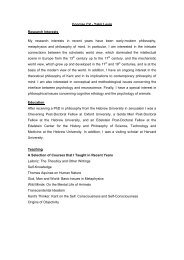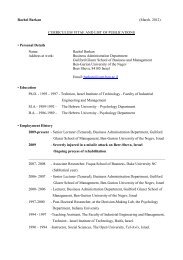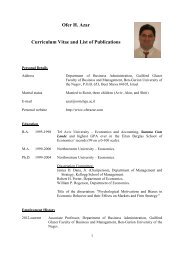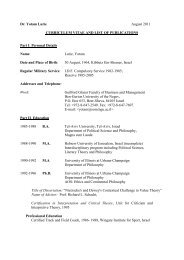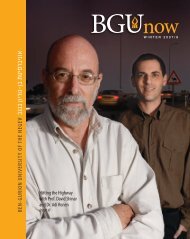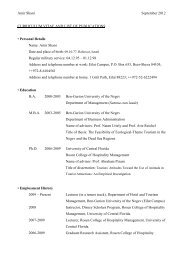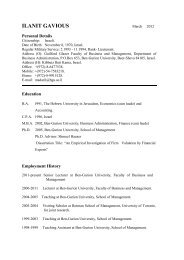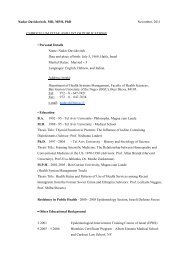Book of Abstracts
Book of Abstracts
Book of Abstracts
Create successful ePaper yourself
Turn your PDF publications into a flip-book with our unique Google optimized e-Paper software.
30<br />
New technique for measuring surface energy balance and soil water evaporation beneath sparse plant<br />
canopies<br />
Thomas Sauer; Soil, Water, and Air Resources Research Unit; USDA-ARS-NLAE; Ames, Iowa, United States;<br />
tom.sauer@ars.usda.gov<br />
Non-uniform surfaces, like sparse canopies in arid environments, <strong>of</strong>fer unique challenges for the measurement <strong>of</strong> the<br />
surface energy balance and evapotranspiration (ET). Obtaining separate measurements <strong>of</strong> soil water evaporation (E)<br />
and plant transpiration (T) is <strong>of</strong>ten critical to improving irrigation water-use efficiency. Sap flow techniques can be<br />
used to measure T <strong>of</strong> individual plants, but the apparatus is expensive and requires frequent attention, and scaling up<br />
to the canopy level can be challenging. Measurement <strong>of</strong> E can be accomplished by micro-lysimeters or soil water<br />
balance techniques, but both techniques <strong>of</strong>ten require many replicate measurements to deal with spatial variation.<br />
We developed a micro Bowen ratio energy balance (MBREB) measurement system to determine E beneath and<br />
between rows <strong>of</strong> vineyards in arid southern Israel and humid western North Carolina, USA. The system measured<br />
air temperature and water vapor pressure 1 and 6 cm above the soil surface. Net radiation (Rn) was measured with<br />
three types <strong>of</strong> net radiometers, and soil heat flux (G) was measured with flux plates. An eddy covariance system<br />
above the canopy measured ET for the vineyard. T was measured with sap flow gauges, and E was measured with<br />
micro-lysimeters and heat dissipation sensors over select intervals for comparison. Overall, the MBREB approach<br />
showed great promise although some challenges remain. Accurate measurements <strong>of</strong> very small vapor pressure<br />
gradients and large temperature gradients so near the soil surface require special care. Uncertainty in the<br />
measurement footprint and the complex, dynamic solar radiation pattern in the vineyard make selection <strong>of</strong> the<br />
relevant net radiometer viewing area challenging. The MBREB has several advantages, including continuous<br />
measurement, no soil disturbance, a relatively large footprint providing good spatial averaging, and the potential to<br />
also obtain soil CO2 flux data.<br />
Sustainable agriculture in water-stressed, arid regions using aeroponics<br />
Navin Kumar C. Twarakavi, Associate Pr<strong>of</strong>essor, Desert Research Institute, Las Vegas, NC 89119. Phone: 001-<br />
702-715-7223. Email: navin.twarakavi@dri.edu<br />
With agriculture contributing minimally to the economy <strong>of</strong> Nevada under conditions <strong>of</strong> a burgeoning population and<br />
increased stress on the availability <strong>of</strong> food and water, the future is highly dependent on the sustainable growth <strong>of</strong> its<br />
urban centers (such as Las Vegas and Reno). Given that tourism is a major industry in Nevada, the need for high<br />
quality fresh produce cannot be understated. Currently, fresh produce (such as fruits and vegetables) are imported in<br />
to Nevada, both nationally and internationally. There are a number <strong>of</strong> issues associated with the transportation <strong>of</strong><br />
fresh produce to cater to the demands <strong>of</strong> Nevadans. Firstly, the carbon footprint <strong>of</strong> transporting fresh produce is<br />
quite significant. Research has shown that growing fresh produce causes 5% <strong>of</strong> a person’s carbon footprint each<br />
year. However, when this fresh produce has to be transported long distances, the amount <strong>of</strong> the carbon footprint<br />
changes to 28%. Secondly, transportation <strong>of</strong> fresh produce results in a loss <strong>of</strong> taste and nutritional quality and a<br />
decreased shelf-life. Also, depending on the type <strong>of</strong> fresh produce, the cost <strong>of</strong> transportation can be as high as 30%<br />
<strong>of</strong> the total cost. The above-stated issues are especially true in the case <strong>of</strong> “cash” crops, such as micro-greens,<br />
nutraceuticals, and spices, among others. In order to grow non-local food locally, greenhouses have been used in the<br />
past. Other systems, such as hydroponics, have been introduced to address the same issue. However, these<br />
approaches do not reduce the water demand, which is not suitable in water-stressed environments such as Nevada.<br />
Systems that allow for high production rates, higher yield/ acreage and year-round production would be suitable.<br />
Aeroponic systems are ideally suited to address these requirements. Here, we present aeroponic systems that are<br />
currently being adapted for Nevada to encourage sustainable agriculture.<br />
Modelling the water balance in low rainfall cereal systems <strong>of</strong> Southern Australia<br />
Anthony M. Whitbread 12 and Jeff A. Baldock 3<br />
1 CSIRO Ecosystem Sciences, Waite Precinct, Adelaide; awhitbr@gwdg.de



